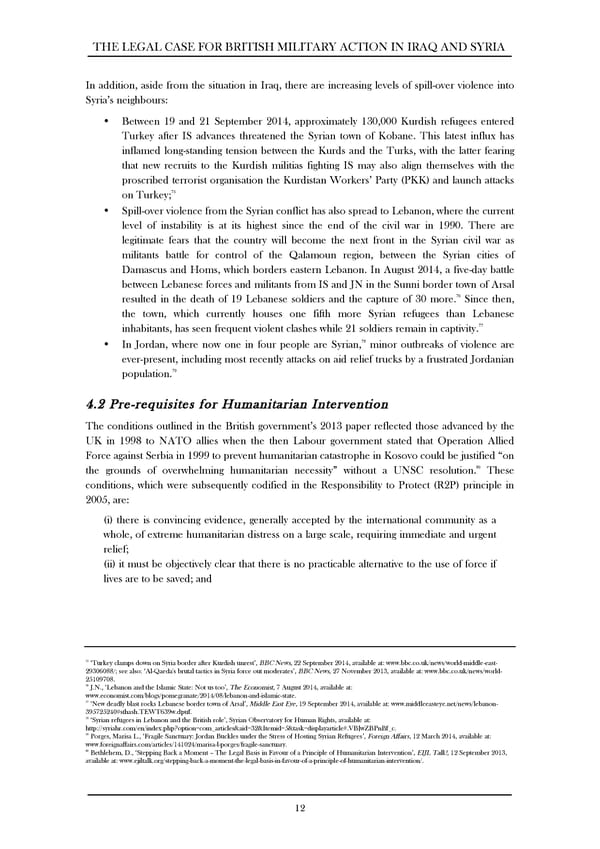THE LEGAL CASE FOR BRITISH MILITARY ACTION IN IRAQ AND SYRIA In addition, aside from the situation in Iraq, there are increasing levels of spill-over violence into Syria’s neighbours: • Between 19 and 21 September 2014, approximately 130,000 Kurdish refugees entered Turkey after IS advances threatened the Syrian town of Kobane. This latest influx has inflamed long-standing tension between the Kurds and the Turks, with the latter fearing that new recruits to the Kurdish militias fighting IS may also align themselves with the proscribed terrorist organisation the Kurdistan Workers’ Party (PKK) and launch attacks 75 on Turkey; • Spill-over violence from the Syrian conflict has also spread to Lebanon, where the current level of instability is at its highest since the end of the civil war in 1990. There are legitimate fears that the country will become the next front in the Syrian civil war as militants battle for control of the Qalamoun region, between the Syrian cities of Damascus and Homs, which borders eastern Lebanon. In August 2014, a five-day battle between Lebanese forces and militants from IS and JN in the Sunni border town of Arsal 76 resulted in the death of 19 Lebanese soldiers and the capture of 30 more. Since then, the town, which currently houses one fifth more Syrian refugees than Lebanese inhabitants, has seen frequent violent clashes while 21 soldiers remain in captivity.77 78 • In Jordan, where now one in four people are Syrian, minor outbreaks of violence are ever-present, including most recently attacks on aid relief trucks by a frustrated Jordanian population.79 4.2 Pre-requisites for Humanitarian Intervention The conditions outlined in the British government’s 2013 paper reflected those advanced by the UK in 1998 to NATO allies when the then Labour government stated that Operation Allied Force against Serbia in 1999 to prevent humanitarian catastrophe in Kosovo could be justified “on 80 the grounds of overwhelming humanitarian necessity” without a UNSC resolution. These conditions, which were subsequently codified in the Responsibility to Protect (R2P) principle in 2005, are: (i) there is convincing evidence, generally accepted by the international community as a whole, of extreme humanitarian distress on a large scale, requiring immediate and urgent relief; (ii) it must be objectively clear that there is no practicable alternative to the use of force if lives are to be saved; and 75 ‘Turkey clamps down on Syria border after Kurdish unrest’, BBC News, 22 September 2014, available at: www.bbc.co.uk/news/world-middle-east- 29306088/; see also: ‘Al-Qaeda's brutal tactics in Syria force out moderates’, BBC News, 27 November 2013, available at: www.bbc.co.uk/news/world- 25109708. 76 J.N., ‘Lebanon and the Islamic State: Not us too’, The Economist, 7 August 2014, available at: www.economist.com/blogs/pomegranate/2014/08/lebanon-and-islamic-state. 77 ‘New deadly blast rocks Lebanese border town of Arsal’, Middle East Eye, 19 September 2014, available at: www.middleeasteye.net/news/lebanon- 395725240#sthash.TEWT639w.dpuf. 78 ‘Syrian refugees in Lebanon and the British role’, Syrian Observatory for Human Rights, available at: http://syriahr.com/en/index.php?option=com_articles&aid=32&Itemid=5&task=displayarticle#.VB]wZBPnBf_c. 79 Porges, Marisa L., ‘Fragile Sanctuary: Jordan Buckles under the Stress of Hosting Syrian Refugees’, Foreign Affairs, 12 March 2014, available at: www.foreignaffairs.com/articles/141024/marisa-l-porges/fragile-sanctuary. 80 Bethlehem, D., ‘Stepping Back a Moment – The Legal Basis in Favour of a Principle of Humanitarian Intervention’, EIJL Talk!, 12 September 2013, available at: www.ejiltalk.org/stepping-back-a-moment-the-legal-basis-in-favour-of-a-principle-of-humanitarian-intervention/. 12
 The legal case for action Page 11 Page 13
The legal case for action Page 11 Page 13